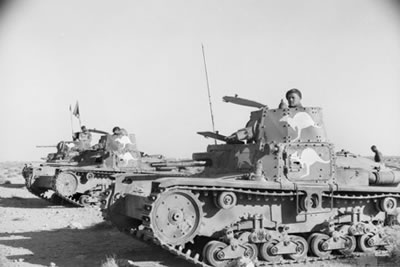During the Siege of Tobruk, which lasted from February to November 1941, during World War II, German and Italian troops, led by General Erwin Rommel, gained control of the city of Tobruk in Libya. The successes of Axis forces during the Siege of Tobruk were largely due to Rommel’s ability to launch effective defenses against British tank forces.
After Italy’s defeat at the end of Operation Compass, Germany decided that it needed to send its own troops to North Africa.
Rommel, who became known as the Desert Fox, was given command of Germany’s Afrika Korps, which was made of two armored division, the 15th Panzer and 5th Light divisions. Each of these divisions contained two panzer battalions, three motorized infantry battalions and support troops. Rommel was also put in charge of Italy’s Ariete armored division.
 Rommel arrived in North Africa in February 1941. Rommel immediately began leading his panzers toward Mersa Brega in Libya, where British forces were stationed.
Rommel arrived in North Africa in February 1941. Rommel immediately began leading his panzers toward Mersa Brega in Libya, where British forces were stationed.
Axis forces attacked by surprise on March 31.
When Rommel attacked, British tank forces had been fighting the Italians for months, and were now in poor shape. Many British tanks were in need of repair. Some British tanks had been left behind in Egypt. Their crews had been issued inferior Italian M13/40 and M11/39 tanks.
In addition, many of the British tank radios were inoperable. This was because the tanks used the same battery for the radio that they used for everything else, so if the radio were used, the battery wouldn’t have enough power to start the engine. With a lack of functional radios, it was hard to transmit orders clearly. Conflicting orders were given, causing confusion among British troops.
Rommel’s troops were able to penetrate Allied lines easily, forcing the Allies to retreat to the east.
By April 3, Rommel’s forces had reached Benghazi, Libya.
The Allies decided to try the tactic of destroying their own fuel supplies, so that Axis tanks could not use them. This tactic backfired; the Allies now did not have enough fuel for their own tanks.
On April 8, Axis forces attacked again. By April 11, the Germans and Italians had cut off Tobruk.
Days later, Allies forces had been driven from all of Cyrenaica in East Libya, except for Tobruk.
Allied infantry, supported by about a dozen Matildas and some British cruiser tanks, defended Tobruk. Although Rommel’s forces were able to penetrate the perimeter of the city, the British were able to maintain a defense. Rommel decided that it was best to contain the British in Tobruk and then move on to targets that were more important strategically.
The British government realized that British troops in North Africa needed more tanks, so they sent an additional 300 tanks.
However, General Archibald Wavell, who was commanding British forces, did not want to wait, and launched a counterattack on May 15, 1941, before the reinforcements arrived. Wavell’s attack failed.
After the new tanks arrived, the Allies launched another counterattack. This also failed.
Rommel’s understanding of how to defend against tanks played an important role in the defeat of British tanks..
He placed large antitank guns in the paths of the tanks.
Rommel’s troops shot at the undersides of British tanks, often disabling them, as the tanks moved over undulating sand.
This was the first time that the British used their A15 Mark VI Cruiser tank, also known as the Crusader. This tank was not as effective as had been hoped. The armor on the Crusader could be penetrated by 2.28 inch (50mm) Panzer III guns as well as by commonly used 2.16 inch (55mm) antitank guns.
The Crusader also broke down easily.
By the time the day was over, approximately half of the British tanks were either disabled or destroyed.
The Panzers launched an attack the following day. This time, they encountered hull-down British tanks that were able to maintain their ground.
Eventually, however, the Allies had to withdraw.
Tobruk remained under siege by Axis forces until November 1941, when it was liberated by the Allies during Operation Crusader.